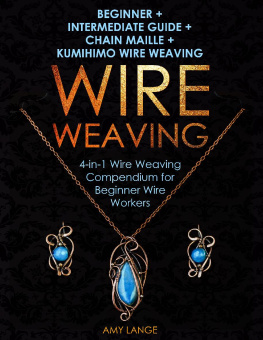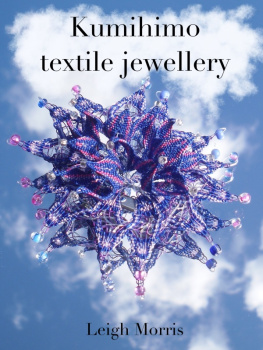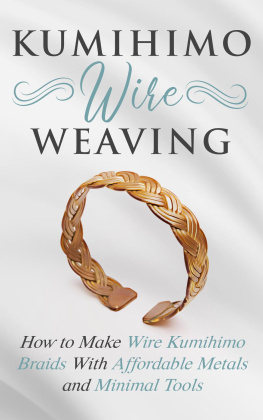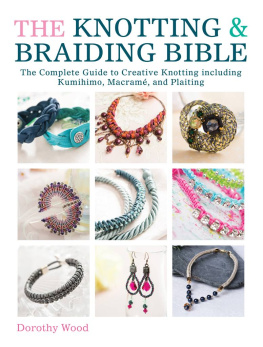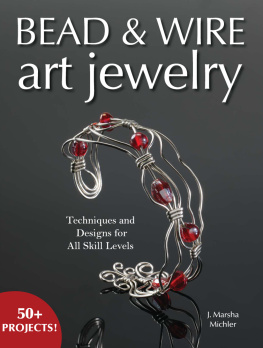Contents
Guide
KUMIHIMO WIREWORK
MADE EASY
20 BRAIDED JEWELRY DESIGNS STEP-BY-STEP
CHRISTINA LARSEN

DEDICATION
To Ronnie O'Sullivan, Liang Wenbo, Neil Robertston, and all the other players who played snooker on TV for me to watch while making this book.
CONTENTS
INTRODUCTION

Kumihimo is an ancient Japanese braiding technique originally used with fiber, which is still the most common material. As the art form has evolved and gained recent popularity, a variety of materials have been introduced into this fascinating technique. Using wire in place of fiber offers new design possibilities as wire responds differently than fiber when braided. A simple act such as removing your braid from the disk without having to worry about it unraveling is possible because unlike fiber, wire holds its shape.
This feature offers new opportunities for what can be done in the world of kumihimo. Braiding wire also leads to a very different finish and appearance of the final piece. Many of the designs in this book explore a variety of ideas for using wire when making braids. Ive discovered that experimenting with alternate design ideas that pop into my mind while braiding a particular piece is the best way to evolve and invent fresh beautiful designs.
Before starting any projects, I highly recommend reading the beginning sections of this book thoroughly as there is a bit of a learning curve with wire kumihimo. Also, try practicing the basic braid structures with less expensive wire or cord until you are comfortable with the techniques. Once you are ready to start the projects, you can refer back to the beginning tutorials as needed.

TOOLS
AND MATERIALS

Choosing the right materials and tools for wire kumihimo is important as they can greatly impact the outcome. Sometimes specific materials or tools are needed to achieve a particular design, while other times you can branch out and experiment with alternatives. I detail the most important things to keep in mind when choosing the materials and tools to use for your wire kumihimo jewelry in this section.
WIRE 101
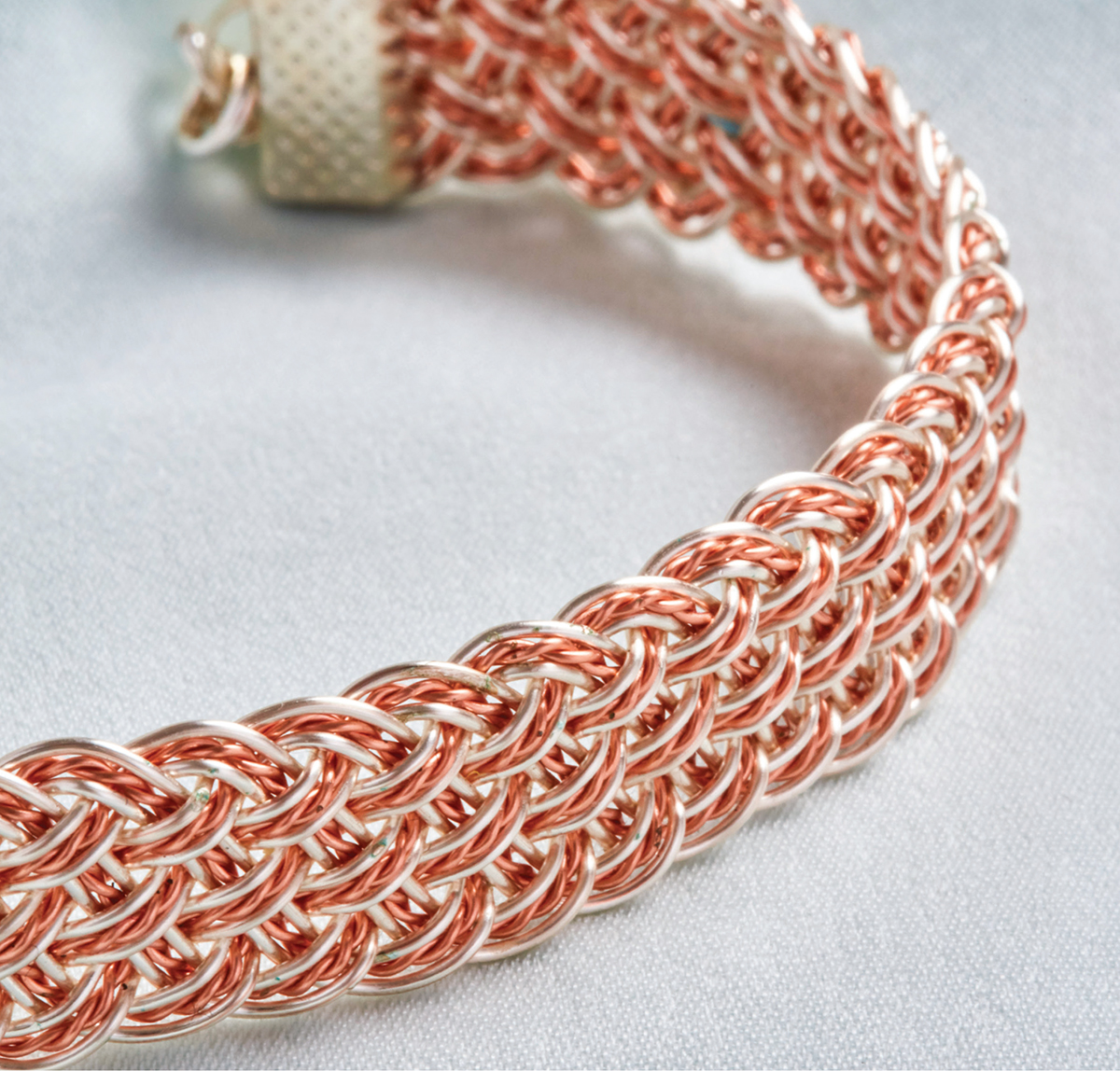
This Elegant Bracelet features twisted wire, which emphasizes the braid structure.
There are several things to take into consideration when choosing materials for wire kumihimo jewelry: what kind of wire to use, which beads fit within the design, and how to finish pieces. Some designs require specific materials to form the braid properly, while others can be customized to work with different materials, depending on the desired look. Choosing a bead with an alternate shape to the one featured in the book could work, but it may give the finished piece a different look. It all comes down to personal preference. Feel free to choose different materials than those featured in the projects, and have fun experimenting!
WIRE HARDNESS
You can use different types of wire for kumihimo. I recommend using a softer wire, such as bare copper, plated copper, craft wire, or sterling silver, because it makes the working process easier and tends to result in a tighter, more even braid. The finished braids are also easier to shape, if the design calls for it.
For wire that has different hardnesses available (see ), I recommend using the dead-soft hardness for the reasons previously stated. Usually the concern with using soft wire is that it wont hold the desired shape as well as harder wire, but that is not as much of a concern with wire kumihimo. There are a few reasons for this. First, there are multiple wires being used at the same time for each braid, which adds to the strength of the final piece, as opposed to jewelry that is made using only one length of wire. Second, as the wire is manipulated it work hardens (becomes stiffer), which in turn makes it stronger. This is beneficial when using wire to make kumihimo because the many movements of forming the braid with the soft wire will result in a strong final piece of jewelry, while still using wire that is easy to work with.
WIRE GAUGE
Wire is widely available in several thicknesses, which are referred to as the wire gauge. The larger the gauge number, the thinner the wire. I recommend using 2030-gauge wire for kumihimo designs as thicker wire is difficult to work with and harder on your hands.
BUYING WIRE
Wire kumihimo tends to use a fair amount of wire due to the nature of the braiding. Wire comes in both small coils and large reels, so it is important to pay attention to the amount of wire required when gathering supplies. Ive eliminated the guesswork by including the exact amount needed to complete each project in the materials list.

WIRE HARDNESS EXPLAINED
When making jewelry with wire, you will often see or hear the term wire hardness. This indicates how much resistance the wire has when bending it. There are usually three different wire hardnesses: dead soft (soft), half hard, and full hard. These all have their place and present different characteristics when working with them. Dead-soft wire is easy to work with but not ideal to use by itself without work hardening it, whereas full-hard wire is very stiff and more difficult to work with but will be much stronger and hold its shape better. Half-hard wire falls in between these two and can be considered the best of both worlds. When working with heavier gauge wires, dead-soft wire and half-hard wire are also more prone to needing work hardening to make them stronger, whereas full-hard wire is often already strong enough.
BEADS FOR KUMIHIMO
Deciding on the type of beads to use for wire kumihimo jewelry is a personal decision and depends on how you want the final piece to look. Some designs will work with many different beads, so you can choose from a variety of types, shapes, and sizes, depending on the look you want. Other designs require beads in specific shapes or sizes to achieve the desired effect.
The most important thing to look for when choosing beads is the size of the holes because they need to be large enough to fit over the wire used to make the braid. It can sometimes be a problem if the holes in your chosen beads are too small for the wire to go through. To avoid disappointment, make sure the wire fits inside each bead hole before starting your project.
There are certain types of beads that work well with wire kumihimo. So, delve into the world of beads and cabochons, and find your personal favorites.



